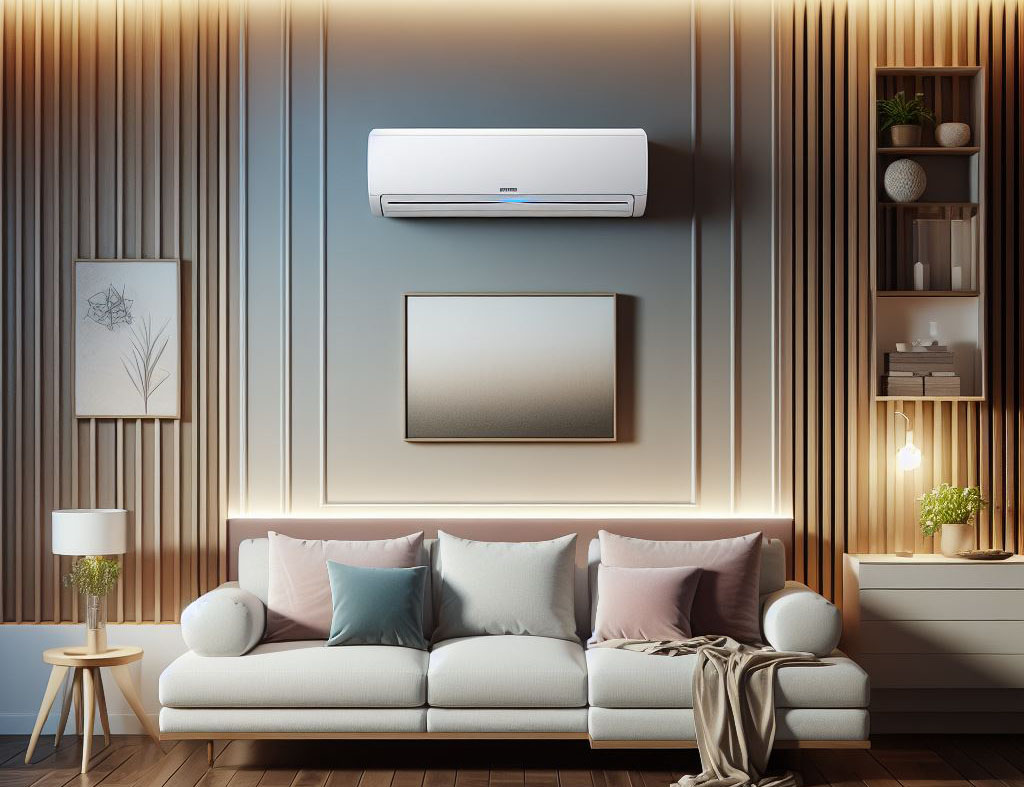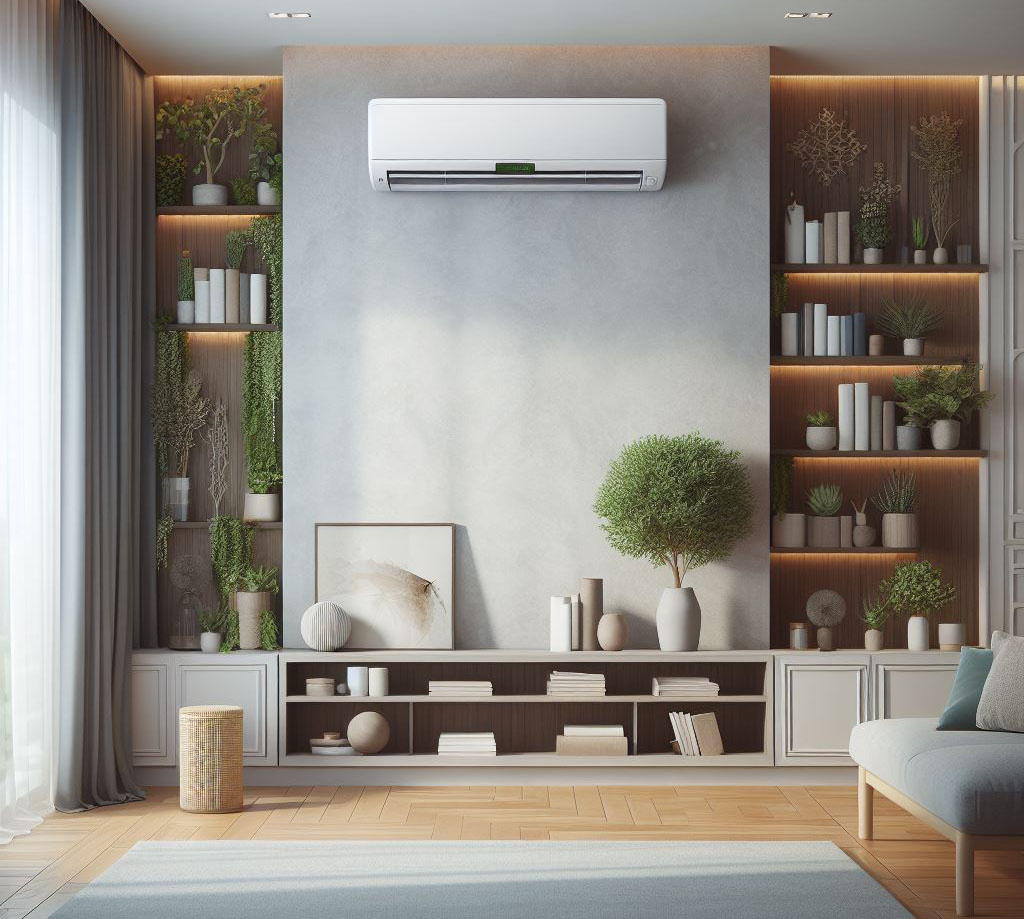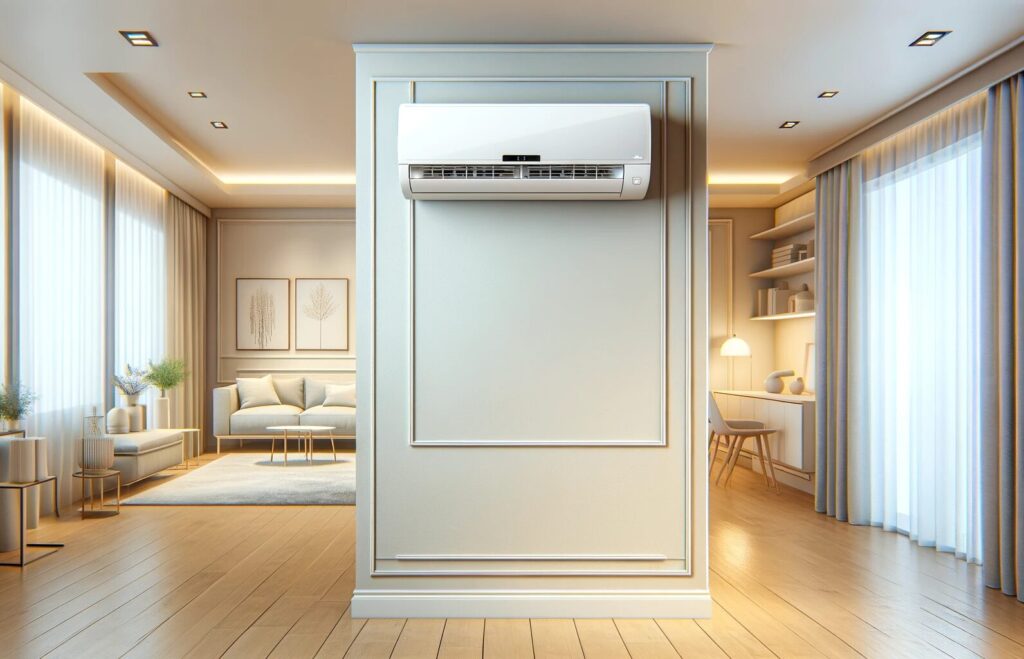In the realm of home comfort, the wall-mounted air conditioner has emerged as a top contender, swiftly becoming a staple in modern homes. Its rise in popularity is no fluke, it’s a testament to its adaptability, efficiency, and the sleek design it offers. This guide is crafted for those with a penchant for home improvement – the home handymen and the independent contractors who take pride in creating comfortable living spaces.

Benefits of Wall-Mounted Air Conditioners
Let’s delve into the advantages that make wall-mounted air conditioners a smart choice for homeowners and builders alike:
- Space-saving design: These units are a boon for optimizing living space. Mounted on the wall, they are unobtrusive, allowing homeowners to reclaim space typically lost to bulky window units or large floor-standing models.
- Energy efficiency and cost-effectiveness: Wall-mounted air conditioners are the embodiment of modern efficiency. With higher SEER ratings, they cool spaces using less energy, which translates into lower utility bills – a benefit any homeowner will appreciate.
- Aesthetic integration into home decor: Today’s wall-mounted units merge seamlessly with interior design. With a variety of styles and finishes, they can complement any room without being an eyesore.
- Zoned cooling capabilities: The ability to cool specific zones within a home is not just a luxury, it’s a strategic way to manage energy consumption. By cooling only the areas in use, homeowners can enjoy both comfort and cost savings.

Types of Wall-Mounted Air Conditioning Units
Understanding the different types of wall-mounted air conditioners is crucial to selecting the right fit for a project:
- Single-zone vs. multi-zone systems: Single-zone systems are designed for individual rooms, providing targeted cooling where it’s needed. Multi-zone systems, on the other hand, offer individualized control over different areas, allowing for customized comfort throughout the home.
- Cooling only vs. wall ac heating units: Some units are designed solely for cooling, while others come with built-in heat pumps, providing a year-round climate control solution that can both cool and warm a space as needed.
- Inverter technology in wall-mounted AC units: Inverter technology is a significant leap forward in climate control. It allows the compressor to operate at variable speeds, delivering precise cooling or heating while conserving energy and extending the unit’s lifespan.
Choosing the Right Wall-Mounted AC Unit
Selecting the appropriate wall-mounted air conditioner is akin to choosing the right materials for a solid foundation:
- Assessing room size and cooling capacity (BTUs): It’s essential to match the unit’s capacity, measured in BTUs, with the room’s size. This ensures efficient operation without overburdening the system or underperforming.
- Considering the climate and insulation of your home: The local climate and home insulation play pivotal roles in determining the capacity and efficiency required of an air conditioning unit. A well-insulated home in a moderate climate will have different needs than a poorly insulated home in a region with extreme temperatures.
- Understanding energy ratings and efficiency: Familiarity with energy ratings is crucial. An ENERGY STAR certification or a high SEER (Seasonal Energy Efficiency Ratio) rating indicates a unit that will deliver maximum cooling with minimal energy consumption, providing long-term savings.

Installation Guide
Embarking on the installation of a wall-mounted AC unit is a task that, while intricate, can be tackled with the right tools and a methodical approach. Let’s break down the necessities and the process.
Tools and Materials Needed for a Wall-Mounted AC Installation
Before we roll up our sleeves, make sure you have the following:
- A reliable drill with a set of bits for various materials
- A level to ensure a straight, professional installation
- A stud finder, because securing the unit to the framework is non-negotiable
- A tape measure for precise placement
- Screwdrivers, both Phillips and flathead, for various fasteners
- A hammer for the occasional persuasive tap
- Piping and ductwork, which will form the circulatory system of your AC
- A wall sleeve or mounting bracket to anchor your unit securely
- Sealant and insulation to protect against the elements and energy loss
- Wire strippers and electrical connectors for safe electrical connections
Step-by-Step Installation Process
With your toolkit ready, follow these steps to ensure a smooth installation:
- Choosing the Location: Identify a spot that allows for optimal airflow and is accessible for future servicing.
- Locating the Studs: Use your stud finder to locate the wall studs and mark their positions.
- Securing the Bracket: Attach the mounting bracket to the studs, using a level to ensure it’s perfectly horizontal.
- Preparing for Piping: Drill a hole for the refrigerant and electrical lines, angled to prevent water ingress.
- Mounting the Indoor Unit: Hang the indoor unit on the bracket, ensuring it clicks securely into place.
- Routing the Connections: Carefully connect the electrical and refrigerant lines, adhering to the manufacturer’s guidelines.
- Sealing the Installation: Apply insulation around the pipes and seal the exterior hole to maintain energy efficiency.
- Positioning the Outdoor Unit: Install the outdoor unit on a stable base, connect it to the indoor unit, and ensure it’s level.
- Evacuating the Lines: Use a vacuum pump to remove air and moisture from the refrigerant lines.
- Starting the System: Once all connections are secure, restore power and test the unit for proper operation.
Safety Precautions and Best Practices
Safety is paramount. Always disconnect power before beginning work. Use protective gear, such as gloves and safety glasses. Adhere to local electrical codes and regulations. If you’re unsure about the electrical work, don’t hesitate to hire a licensed electrician.

Maintenance Tips for Wall-Mounted AC Units
Maintaining your wall-mounted AC unit is essential for longevity and efficiency. Here’s how to keep it in top condition.
Regular Cleaning and Filter Replacement
- Filter Maintenance: Clean or replace the air filters every few months to ensure efficient operation.
- Unit Cleaning: Regularly dust and wipe down the unit to prevent buildup that can impede airflow.
Seasonal Checks and Upkeep
- Pre-season Preparation: At the onset of the cooling season, inspect the unit, check refrigerant levels, and verify that all components are functioning correctly.
- End-of-Season Care: If the unit won’t be used for an extended period, cover the outdoor component to protect it from the elements.
Troubleshooting Common Issues
- Water Leakage: Inspect the condensate drain for clogs and clear as needed.
- Inadequate Cooling: Verify thermostat settings and clean filters. If the issue persists, consult a professional.
Cost Analysis
When considering the cost of a wall-mounted AC, it’s important to weigh the initial investment against potential savings.
Initial Investment vs. Long-Term Savings
- Upfront Expense: The purchase price and installation can be substantial, but the investment pays dividends in comfort and efficiency.
- Efficiency Savings: These units are designed to minimize energy usage, which can lead to significant savings on utility bills over time.
Comparison with Other Cooling Systems
- Central Air: Generally has a higher initial cost and can be more expensive to operate, but offers whole-house comfort.
- Window Units: Less expensive upfront but can be less energy-efficient and obstructive.
Tips for Finding the Best Deals on Wall-Mounted Air Conditioners
- Timing Your Purchase: Off-season shopping can yield better prices.
- Rebates and Incentives: Look for manufacturer rebates and government incentives for energy-efficient appliances.
- Research: Compare prices, read reviews, and don’t overlook the value of a good warranty.
DIY vs. Professional Installation
When you’re weighing the options between DIY and professional installation for your wall-mounted AC, consider your skills and the complexity of the job. If you’re adept with tools and can interpret technical instructions, you might enjoy the challenge of a DIY project. It’s akin to a chef perfectly executing a complex recipe – it requires precision, patience, and the right equipment.
When to Tackle Installation Yourself
Embarking on a DIY installation can be rewarding. If you’re familiar with the basic principles of carpentry and electrical work, and can safely handle a drill and a level, you might be ready to take on the task. However, it’s crucial to understand the structure of your walls – one wrong move could lead to costly repairs. If you’re comfortable with these conditions and prepared for a bit of troubleshooting along the way, DIY could be a viable option.
Scenarios Where Hiring a Professional is Recommended
There are times when hiring a professional is the prudent choice. If your project involves extensive electrical work, or if you’re not confident in your ability to handle refrigerant, it’s time to call in a licensed technician. Professionals bring a wealth of experience, ensuring that your installation is safe, efficient, and up to code. This is particularly important in older homes where unexpected challenges often arise.
Licensing and Permits Considerations
Before proceeding with any installation, familiarize yourself with local building codes and permit requirements. A professional installer will navigate these legalities for you, ensuring that your installation meets all necessary regulations and that your warranty remains valid. It’s not just about compliance – it’s about safety and the assurance that your installation is performed correctly.
Innovations in Wall-Mounted Air Conditioning Technology
The field of air conditioning is advancing rapidly, with new technologies that enhance comfort and reduce environmental impact.
Smart Home Integration
Modern wall-mounted AC units can now seamlessly integrate with smart home systems, allowing for remote control and automation. This technology offers the convenience of adjusting your home’s temperature from anywhere, ensuring a comfortable environment upon your arrival without wasting energy when you’re away.
Improved Refrigerants for Environmental Sustainability
The industry has made significant strides in developing environmentally friendly refrigerants. These new compounds have a lower global warming potential and are designed to meet stringent environmental regulations without sacrificing performance.
Noise Reduction Advancements
Advancements in noise reduction have transformed the operation of wall-mounted AC units. Modern units employ advanced fan blade designs and vibration-dampening technologies to operate quietly, ensuring that your home remains a tranquil sanctuary.
FAQ Section
Wall-mounted air conditioners offer a more permanent and aesthetically pleasing solution compared to traditional window units. They require a more involved installation process but provide better distribution of cool air and do not obstruct window space. Additionally, wall-mounted units are generally more energy-efficient and quieter in operation.
Sizing an AC unit correctly is essential for optimal performance. You’ll need to calculate the room’s square footage and consider factors such as ceiling height, insulation quality, and sun exposure. A unit that’s too small won’t cool effectively, while one that’s too large will cycle on and off too frequently, reducing efficiency and comfort.
The installation of a wall-mounted AC unit requires careful consideration of the wall’s structure. You need to ensure the wall can support the weight of the unit and allow for proper installation of the venting system. Exterior walls are typically preferred for the ease of connecting the unit to the outdoor compressor.
Routine maintenance is key to the longevity and efficiency of your wall-mounted AC. This includes regular cleaning of the air filters, checking the refrigerant levels, and ensuring the system is free of dust and debris. Annual inspections by a professional are also recommended to maintain optimal performance.
Wall-mounted air conditioners are designed with energy efficiency in mind. They often feature higher SEER (Seasonal Energy Efficiency Ratio) ratings compared to traditional window units, which translates to lower energy consumption and cost savings over time.
Filters should be checked monthly and replaced or cleaned as needed – typically every 1 to 3 months, depending on usage and environmental factors. Clean filters are essential for maintaining air quality and unit efficiency.
Many wall-mounted AC units come with a heat pump function, allowing them to provide heating as well as cooling. This dual functionality makes them a versatile option for year-round climate control in your home.
Start by checking the most common issues: a dirty filter, incorrect thermostat settings, or blocked airflow. If these aren’t the culprits, it’s best to consult with a professional to diagnose and address the problem, as it could be related to the refrigerant levels or a mechanical issue.
